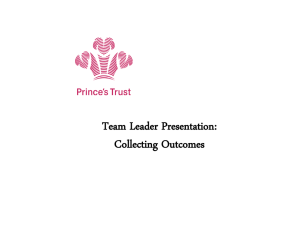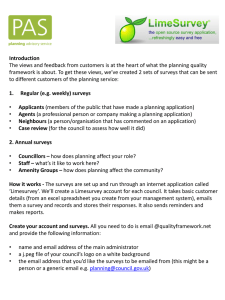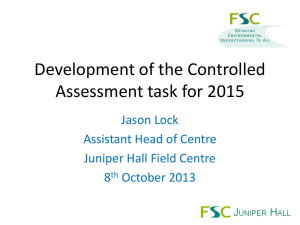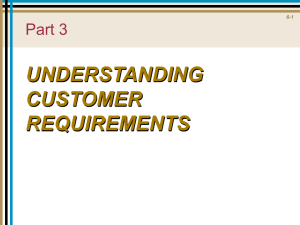Online surveys as data collection instruments in education
advertisement
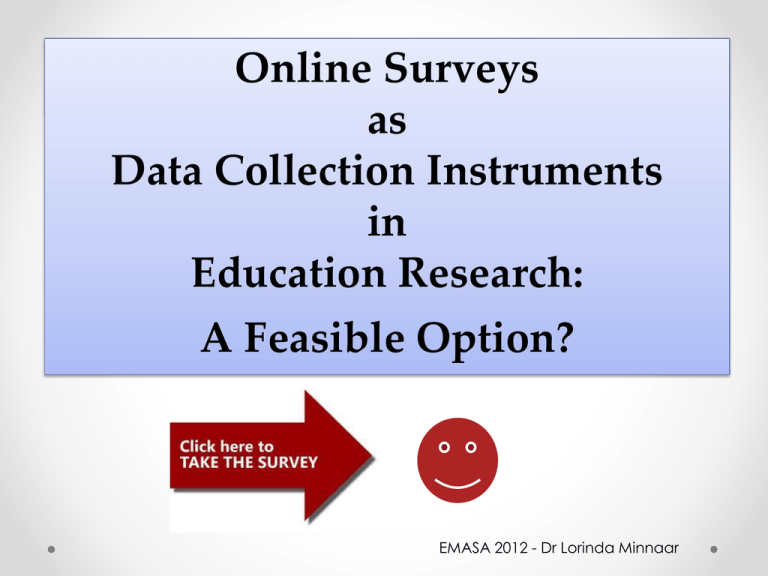
Online Surveys as Data Collection Instruments in Education Research: A Feasible Option? EMASA 2012 - Dr Lorinda Minnaar Introduction Study Title School Governance and Leadership for Sustainable Quality Education for All Study Theme School governance and leadership Key Purpose of the Study To explore and establish the ability of parent members of school governing bodies to govern and manage schools’ finances Research Design Approach Large-scale, exploratory, quantitative study Sample All (1433) schools in the Western Cape (WCED) Participants School principals Data Collection Instrument Online survey Motivation for Choice of an Online Survey • Large sample – 1433 schools • Financial and human resource constraints • An online survey is a convenient and cost-effective data collection method • Access to“Checkbox” Review of Literature on Online Surveys Problem Despite an extensive search, existing literature documenting the feasibility of this data collection method in an education research context, seems deficient Solution Adapt existing literature to the purpose and design of the study, located within a South African educational research context Types of Online Surveys E-mail an introductory letter or invitation to respondents with a Uniform Resource Locator (URL) hyperlink to a web-based survey Send respondents a survey embedded in an e-mail message with or without an attachment Place a general request for respondents in an electronic communication environment such as a web page to complete a survey Advantages of Online Surveys Global reach Large samples easily accessed Time-efficient and convenient Low preparation and administration costs Environmentally friendly Question diversity Question sequencing capabilities Question branching capabilities Ease of data entry and analysis Disadvantages of Online Surveys Perceptions as Spam Lack of participant online experience and expertise Computer configuration Impersonal Security and confidentiality Planning the Online Survey Planning the online survey entailed: • Drafting the hard copy • Placing instructions, questions and answer options in simple tables • Continually revising instructions and questions to ensure they did not contain design errors such as confusing ambiguities, double, split and negative questions and value-laden concepts • Consulting an expert in the field of school governance to seek confirmation that questions were valid, meaningful, grammatically correct and appropriate to the research theme Designing the Online Survey Designing the online survey entailed the following methodological considerations: • Selecting a visual layout comprising design elements such as background colour, font face, size and colour • Uploading Stellenbosch University’s oak leaf logo, which not only lent colour and formality to the survey but immediately informed participants of the survey’s origin • Avoiding and eliminating complex, vague and ambiguous instructions that may perplex and frustrate participants to such an extent that they exit the survey before completing it Designing the Online Survey (Cont). • Checking the survey’s length to ensure it was not too long and that participants would not spend too much time completing it Long surveys with matrix type questions that have numerous items and alternatives, increase respondent fatigue and boredom and frequently result in respondents adopting a “satisficing” behaviour where they select the same scale-point to rate all items without paying them much attention (Mora 2010) Question Formats Radio Buttons A list from which a participant selects one option Question Formats (Cont). Checkboxes A list from which the participant may select multiple options Question Formats (Cont). Drop-Down Lists A space-saving format Question Formats (Cont). Open-Ended Single-Line Text Allows freeform text with formatting rules Question Formats (Cont). Open-Ended Multi-Line Text Allows freeform text within a box with a specified number of rows and columns Question Formats (Cont). Matrixes and Rating Scales Explore the frequency of participants’ behaviour or their attitudes toward certain phenomena Activating the Online Survey Activating the online survey included the following aspects: • Sourcing the e-mail addresses of schools in the sample • Checking e-mail addresses for errors • Deliberating on which day, week and month to activate the survey • Determining the period permitted for participants to respond and the final date for submission • The frequency of reminders to be sent to participants • Compiling an appropriate invitation to principals to participate in the survey Activating the Online Survey (Cont). The invitation to participate in the online survey Response Rates and Results Activation and Reminders Number of Surveys sent Number of Surveys Completed and Returned Response Rate 1st 1 433 64 4% 2nd 1 433 44 3% 3rd 1 433 37 2% 4th 1 433 220 15% 24% Overall Response Rate Low response rates appear typical of online surveys Response Rates and Results (Cont). Participants’ Responses to the Quality of the Survey Bar/Column Plot of Count of 1 Spreadsheet14 3v*6c 45 40 35 18% 15% 15% 30 25 20 15 10 5 1% 0% 0 3 Relevant 1 Quick 2 Interesting 0% 4 Long Other Quality of survey 5 Complicated Count of 1 Conclusion “How feasible are Internet-based online surveys used as data collection instruments for educational research?” • Denscombe (2009, 281) asserts “There are still several unanswered questions concerning the use of online surveys as data collection instruments for research purposes”. • Despite implementation of salient methodological considerations, the relatively low response rate alerts educational researchers to use online surveys as data collection instruments circumspectly.





